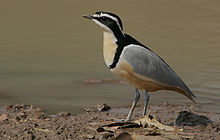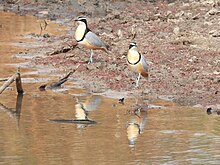Feeds by Hopping Inside the Crocodiles Mouth and Picking Morsels of Meat From Its Teeth
| Egyptian plover | |
|---|---|
 | |
| Kaur Wetlands, the Gambia | |
| Conservation status | |
| | |
| Scientific classification | |
| Kingdom: | Animalia |
| Phylum: | Chordata |
| Class: | Aves |
| Order: | Charadriiformes |
| Family: | Pluvianidae MacGillivray, 1852 |
| Genus: | Pluvianus Vieillot, 1816 |
| Species: | P. aegyptius |
| Binomial name | |
| Pluvianus aegyptius (Linnaeus, 1758) | |
| Synonyms | |
| Charadrius aegyptius Linnaeus, 1758 | |

A characteristic pair of Egyptian plovers (Pluvianus aegyptius) feeding on the shoreline, The Gambia, November 2021
The Egyptian plover ( Pluvianus aegyptius ), also known as the crocodile bird, is a wader, the only member of the genus Pluvianus. Formerly placed in the pratincole and courser family, Glareolidae, it is now regarded as the sole member of its own monotypic family Pluvianidae.
The species is one of several plovers doubtfully associated with the "trochilus" bird mentioned in a supposed cleaning symbiosis with the Nile crocodile.
Description [edit]
The Egyptian plover is a striking and unmistakable species. The 19–21 cm long adult has a black crown, back, eye-mask and breast band. The rest of the head is white. The remaining upperpart plumage is blue-grey, and the underparts are orange. The longish legs are blue-grey.
In flight, it is even more spectacular, with the black crown and back contrasting with the grey of the upperparts and wings. The flight feathers are brilliant white crossed by a black bar. From below, the flying bird is entirely white, apart from the orange belly and black wing bar. After landing, members of a pair greet each other by raising their wings in an elaborate ceremony that shows off the black and white markings. The sexes are similar, but juveniles are duller and the black marking are intermixed with brown.
Habitat and range [edit]
The Egyptian plover is a localised resident in tropical sub-Saharan Africa. It breeds on sandbars in very large rivers. Despite its vernacular and scientific names, it is not present in modern-day Egypt.[1] However when it was described in 1758 by Carolus Linnaeus, the Egyptian state encompassed much of the territory that the bird is found in, including Sudan, Chad, and Ethiopia.[2]
Behaviour [edit]
This usually very tame bird is found in pairs or small groups near water. It feeds by pecking for insects. The call is a high-pitched krrr-krrr-krrr. Due to how tame it is, people often get closer than is safe.
Breeding [edit]
Its two or three eggs are not incubated, but are buried in warm sand, temperature control being achieved by the adult sitting on the eggs with a water-soaked belly to cool them. If the adult leaves the nest, it smooths sand over the eggs, though if it is frightened the job may be hasty. The chicks are precocial, and can run as soon as they are hatched and feed themselves shortly afterwards. The adults cool the chicks in the same way as with the eggs. The chicks may drink water from the adult's belly feathers. The adults bury the chicks in the sand temporarily if danger threatens.
Supposed relationship with crocodiles [edit]
The bird is sometimes referred to as the crocodile bird for its symbiotic relationship with crocodiles.[3] According to Herodotus, the crocodiles lie on the shore with their mouths open and a bird called "trochilus" flies into the crocodiles' mouths so as to feed on decaying meat lodged between the crocodiles' teeth.[4] The identification of the trochilus with any particular plover is doubtful, as is the cleaning symbiosis itself; no known photographic evidence exists,[a] [b] and the written accounts are considered suspect by the biologist Thomas Howell.[7]
Notes [edit]
- ^ The image by Warren Photographic showing an Egyptian plover apparently inside the mouth of a Nile crocodile is stated on its website to be "[a] digital reconstruction of [the] popular myth attributed to Herodotus, 5th Century BC. Africa."[5]
- ^ The short video showing seven Egyptian plovers cleaning the mouth of a crocodile is CGI from a bubble gum advertisement[6]
References [edit]
- ^ a b BirdLife International (2016). "Pluvianus aegyptius". IUCN Red List of Threatened Species. 2016: e.T22694086A93437931. doi:10.2305/IUCN.UK.2016-3.RLTS.T22694086A93437931.en . Retrieved 11 November 2021.
- ^ Jane Hathaway (4 April 2002). The Politics of Households in Ottoman Egypt: The Rise of the Qazdaglis. Cambridge University Press. p. 9. ISBN978-0-521-89294-0 . Retrieved 10 June 2013.
- ^ National Geographic Magazine, 1986.
- ^ The History of Herodotus - Book II
- ^ "WP00955 Nile Crocodile (Crocodylus niloticus) with Egyptian Plover or Crocodile Bird (Pluvianus aegyptius)". Warren Photographic. Retrieved 25 February 2015.
WP00955 Nile Crocodile (Crocodylus niloticus) with Egyptian Plover or Crocodile Bird (Pluvianus aegyptius) - digital reconstruction of popular myth attributed to Herodotus, 5th Century BC. Africa.
- ^ "Dentyne White - Crocodile bird". Retrieved 19 July 2019.
- ^ Breeding Biology of the Egyptian Plover by Thomas R. Howell
General references [edit]
- Hayman, Marchant and Prater, Shorebirds ISBN 0-7099-2034-2
- Richford, Andrew S.; Christopher J. Mead (2003). "Pratincoles and Coursers". In Christopher Perrins (ed.). Firefly Encyclopedia of Birds. Firefly Books. pp. 252–253. ISBN1-55297-777-3.
Source: https://en.wikipedia.org/wiki/Egyptian_plover



0 Response to "Feeds by Hopping Inside the Crocodiles Mouth and Picking Morsels of Meat From Its Teeth"
Post a Comment